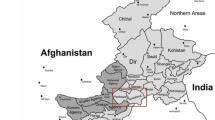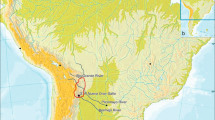Abstract
In order to better characterize and understand the mtDNA population genetics of Central Asia, the mtDNA control regions of over 1,500 individuals from Uzbekistan have been sequenced. Although all samples were obtained from individuals residing in Uzbekistan, individuals with direct ancestry from neighboring Central Asian countries are included. Individuals of Uzbek ancestry represent five distinct geographic regions of Uzbekistan: Fergana, Karakalpakstan, Khorezm, Qashkadarya, and Tashkent. Individuals with direct ancestry in nearby countries originate from Kazakhstan, Kyrgyzstan, Russia, Afghanistan, Turkmenistan, and Tajikistan. Our data reinforce the evidence of distinct clinal patterns that have been described among Central Asian populations with classical, mtDNA, and Y-chromosomal markers. Our data also reveal hallmarks of recent demographic events. Despite their current close geographic proximity, the populations with ancestry in neighboring countries show little sign of admixture and retain the primary mtDNA patterns of their source populations. The genetic distances and haplogroup distributions among the ethnic populations are more indicative of a broad east–west cline among their source populations than of their relatively small geographic distances from one another in Uzbekistan. Given the significant mtDNA heterogeneity detected, our results emphasize the need for heightened caution in the forensic interpretation of mtDNA data in regions as historically rich and genetically diverse as Central Asia.






Similar content being viewed by others
References
Wells RS, Yuldasheva N, Ruzibakiev R, Underhill PA, Evseeva I, Blue-Smith J, Jin L, Su B, Pitchappan R, Shanmugalakshmi S, Balakrishnan K, Read M, Pearson NM, Zerjal T, Webster MT, Zholoshvili I, Jamarjashvili E, Gambarov S, Nikbin B, Dostiev A, Aknazarov O, Zalloua P, Tsoy I, Kitaev M, Mirrakhimov M, Chariew A, Bodmer WF (2001) The Eurasian heartland: a continental perspective on Y-chromosome diversity. Proc Natl Acad Sci 98:10244–49
Cavalli-Sforza LL, Menozzi P, Piazza A (1994) The history and geography of human genes. Princeton University Press, New Jersey
Lahr MM, Foley R (1994) Multiple dispersals and modern human origins. Evol Anthropol 3:48–60
Maca-Meyer N, Gonzalez AM, Larruga J, Flores C, Cabrer V (2001) Major genomic mitochondrial lineages delineate early human expansions. BMC Genetics 2:13
Tanaka M, Cabrera VM, González AM, Larruga JM, Takeyasu T, Fuku N, Guo LJ, Hirose R, Fujita Y, Kurata M, Shinoda K, Umetsu K, Yamada Y, Oshida Y, Sato Y, Hattori N, Mizuno Y, Arai Y, Hirose N, Ohta S, Ogawa O, Tanaka Y, Kawamori R, Shamoto-Nagai M, Maruyama W, Shimokata H, Suzuki R, Shimodaira H (2004) Mitochondrial genome variation in eastern Asia and the peopling of Japan. Genome Res 14:1832–1850
Comas D, Calafell F, Mateu E, Perez-Lezaun A, Bosch E, Martinez-Arias R, Clarimon J, Facchini F, Giovanni F, Luiselli D, Pettener D, Pertranpetit B (1998) Trading genes along the Silk Road: mtDNA sequences and the origin of Central Asian populations. Am J Hum Genet 63:1824–1838
Calafell F, Comas D, Perez-Lezaun A, Bertranpetit J (2000) Genetics and the population history of Central Asia. In: Renfrew C, Boyle K (eds) Archaeogenetics: DNA and the population history of Europe. McDonald Institute for Archaeological Research, Cambridge
Quintana-Murci L, Chaix R, Wells S, Behar D, Sayar H, Scozzari R, Rengo C, Al-Zahery N, Semino O, Santachiara-Benerecetti S, Coppa A, Ayub Q, Mohyuddin A, Tyler-Smith C, Mehdi Q, Torroni A, McElreavey K (2004) Where west meets east: the complex mtDNA landscape of the Southwest and Central Asian corridor. Am J Hum Genet 74:827–45
Comas D, Plaza S, Wells RS, Yuldaseva N, Lao O, Calafell F, Bertranpetit J (2004) Admixture, migrations, and dispersals in Central Asia: evidence from maternal DNA lineages. Eur J Hum Genet 12:495–504
Macaulay V, Hill C, Achilli A, Rengo C, Clarke D, Meehan W, Blackburn J, Semino O, Scozzari R, Cruciani F, Taha A, Shaari NK, Raja JM, Ismail P, Zainuddin Z, Goodwin W, Bulbeck D, Bandelt HJ, Oppenheimer S, Torroni A, Richards M (2005) Single, rapid coastal settlement of Asia revealed by analysis of complete mitochondrial genomes. Science 308:1034–36
Laluela-Fox C, Sampietro ML, Gilbert MTP, Castri L, Facchini F, Pettener D, Bertranpetit J (2004) Unravelling migrations in the steppe: mitochondrial DNA sequences from ancient Central Asians. Proc Biol Sci 271:941–7
Chaix R, Quintana-Murci L, Hegay T, Hammer MF, Mobasher Z, Austerlitz F, Heyer E (2007) From social to genetic structures in Central Asia. Curr Biol 17:43–8
Pérez-Lezaun A, Calafell F, Comas D, Mateu E, Bosch E, Martínez-Arias R, Clarimón J, Fiori G, Luiselli D, Facchini F, Pettener D, Bertranpetit J (1999) Sex-specific migration patterns in Central Asian populations, revealed by analysis of Y-chromosome short tandem repeats and mtDNA. Am J Hum Genet 65:208–19
Yao YG, Lu XM, Luo HR, Li WS, Zhang YP (2000) Gene admixture in the Silk Road region of China: evidence from mtDNA and melanocortin 1 receptor polymorphism. Genes Genet Syst 75:173–178
Zerjal T, Wells RS, Yuldasheva N, Ruzibakiev R, Tyler-Smith C (2002) A genetic landscape reshaped by recent events: Y-chromosomal insights into Central Asia. Am J Hum Genet 71:466–482
Chaix R, Austerlitz F, Hegay T, Quintana-Murci L, Heyer E (2008) Genetic traces of east-to-west human expansion waves in Eurasia. Am J Phys Anthropol 136:309–317
Segurel L, Martinez-Cruz B, Quintana-Murci L, Balaresque P, Georges M, Hegay T, Aldashev A, Nasyrova F, Jobling MA, Heyer E, Vitalis R (2008) PLoS Genet 4:e1000200
Heyer E, Balaresque P, Jobling MA, Quintana-Murci L, Chaix R, Segurel L, Aldashev A, Hegay T (2009) BMC Genetics 10:49. doi:10.1186/1471-2156-10-49
Irwin J, Saunier J, Strouss K, Sturk K, Diegoli T, Just R, Coble M, Parson W, Parsons T (2007) Development and expansion of high quality control region databases to improve forensic mtDNA evidence interpretation. Forensic Sci Int: Genetics 1:154–157
Bandelt HJ, Lahermo P, Richards M, Macaulay V (2001) Detecting errors in mtDNA data by phylogenetic analysis. Int J Legal Med 115:64–69
Bandelt HJ, Quintana-Murci L, Salas A, Macaulay V (2002) The fingerprint of phantom mutations in mitochondrial DNA data. Am J Hum Genet 71:1150–1160
Bandelt HJ, Parson W (2008) Consistent treatment of length variants in the human mtDNA control region: a reappraisal. Int J Legal Med 122:11–21
Excoffier L, Smouse P, Quattro J (1992) Analysis of molecular variance inferred from metric distances among DNA haplotypes: application to human mitochondrial DNA restriction data. Genetics 131:479–491
Nei M (1987) Molecular evolutionary genetics. Columbia University Press, New York
Stoneking M, Hedgecock D, Higuchi RG, Vigilant L, Erlich HA (1991) Population variation of human mtDNA control region sequences detected by enzymatic amplification and sequence-specific oligonucleotide probes. Am J Hum Genet 48:370–382
Excoffier L, Laval G, Schneider S (2005) Arlequin ver. 3.1: an integrated software package for population genetics data analysis. Evol Bioinform Online 1:47–50
van Oven M, Kayser M (2009) Updated comprehensive phylogenetic tree of global human mitochondrial DNA variation. Hum Mutat 30(2):E386–E394 http://www.phylotree.org
Alvarez-Iglesias V, Jaime JC, Carracedo A, Salas A (2007) Coding region mitochondrial DNA SNPs: targeting East Asian and Native American haplogroups. Forensic Sci Int: Genetics 1:44–55
Acknowledgements
The authors would like to thank Kimberly Sturk, Toni Diegoli, Katharine Strouss, Carla Paintner, Daniela Niederwieser, Bettina Zimmermann, and Gabriela Huber for excellent technical assistance; collaborators Dilobar Akhmedova, and Nizom Rakhmatullaev; Nina Duftner for data analysis; Rebecca Just, Michael Coble, and Ibrokhim Abdurakhmanov for helpful discussion; and the Armed Forces Institute of Pathology, the American Registry of Pathology, James Canik, Brion Smith, and Louis Finelli for logistical and administrative support. Part of this research received support from the FWF Austrian Science Fund (L397). The opinions and assertions contained herein are solely those of the authors and are not to be construed as official or as views of the U.S. Department of Defense, the U.S. Department of the Army, or the U.S. Department of Justice.
Author information
Authors and Affiliations
Corresponding author
Electronic supplementary material
Below is the link to the electronic supplementary material.
Supplementary Table 1
MtDNA haplotypes from 1,575 individuals residing in Uzbekistan, listed as differences from the rCRS. Haplotypes are preceded by a header line (denoted with a #! symbol) which specifies the sites assayed for a given set of samples. In all cases, the entire control region was sequenced. Samples are labeled according to: AFG (Afghanistan), KYR (Kyrgyzstan), KAZ (Kazakhstan), RUS (Russia), TAJ (Tajikistan), TUR (Turkmenistan), FER (Uzbekistan–Fergana), KAR (Uzbekistan–Karakalpakstan), QAS (Uzbekistan–Qashkadarya), TAS (Uzbekitan–Tashkent), XOR (Uzbekistan–Khorezm) (PDF 339 kb)
Supplementary Table 2
Фst values for regional subpopulations of Uzbekistan with Uzbek ancestry. Values are not significant at the 0.05 level after Bonferroni correction. (DOC 148 kb)
Supplementary Table 3
Фst values for ethnic populations of Uzbekistan. All values are statistically significant at the 0.05 level after Bonferroni correction (DOC 12.0 kb)
Rights and permissions
About this article
Cite this article
Irwin, J.A., Ikramov, A., Saunier, J. et al. The mtDNA composition of Uzbekistan: a microcosm of Central Asian patterns. Int J Legal Med 124, 195–204 (2010). https://doi.org/10.1007/s00414-009-0406-z
Received:
Accepted:
Published:
Issue Date:
DOI: https://doi.org/10.1007/s00414-009-0406-z




